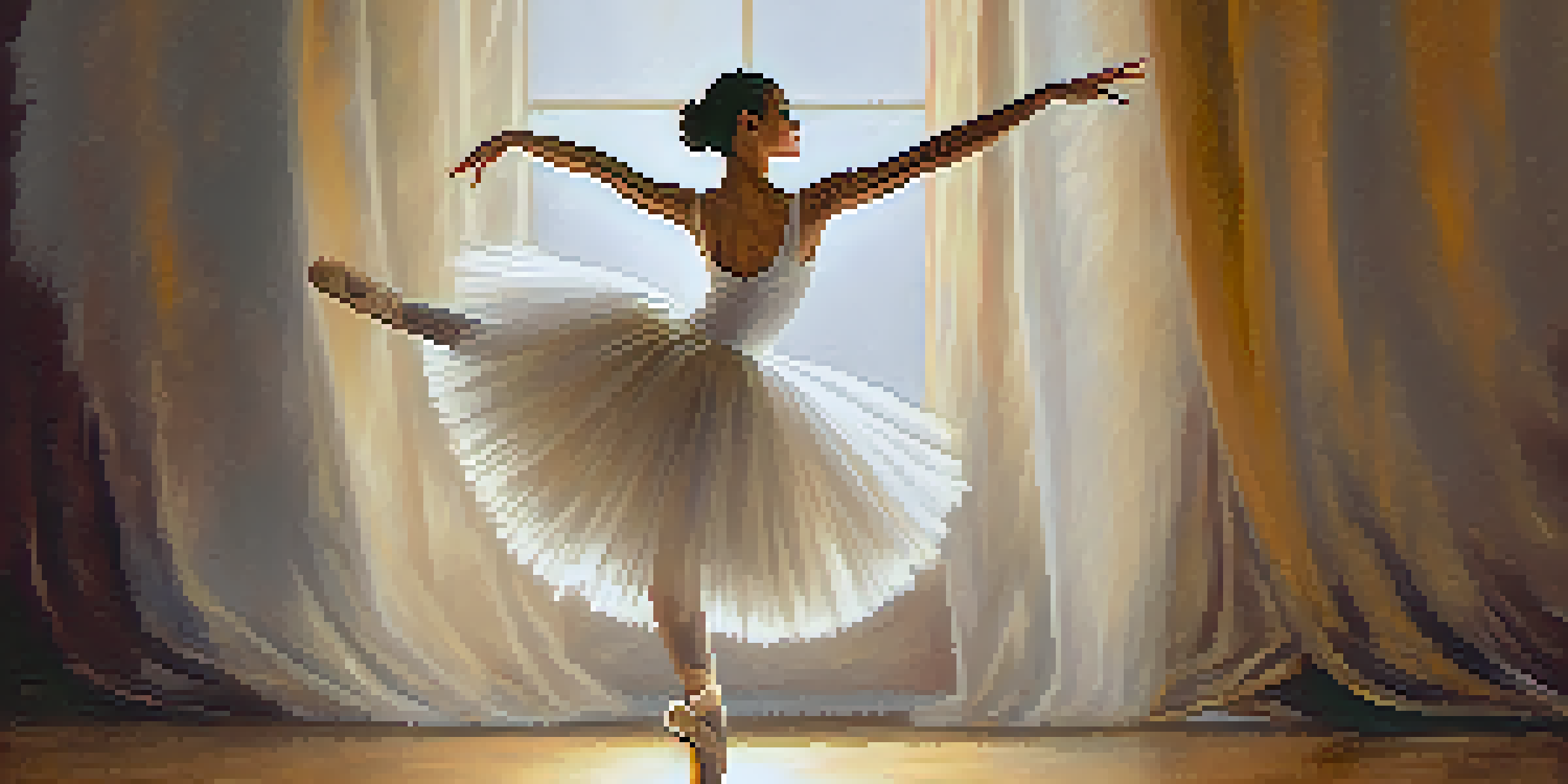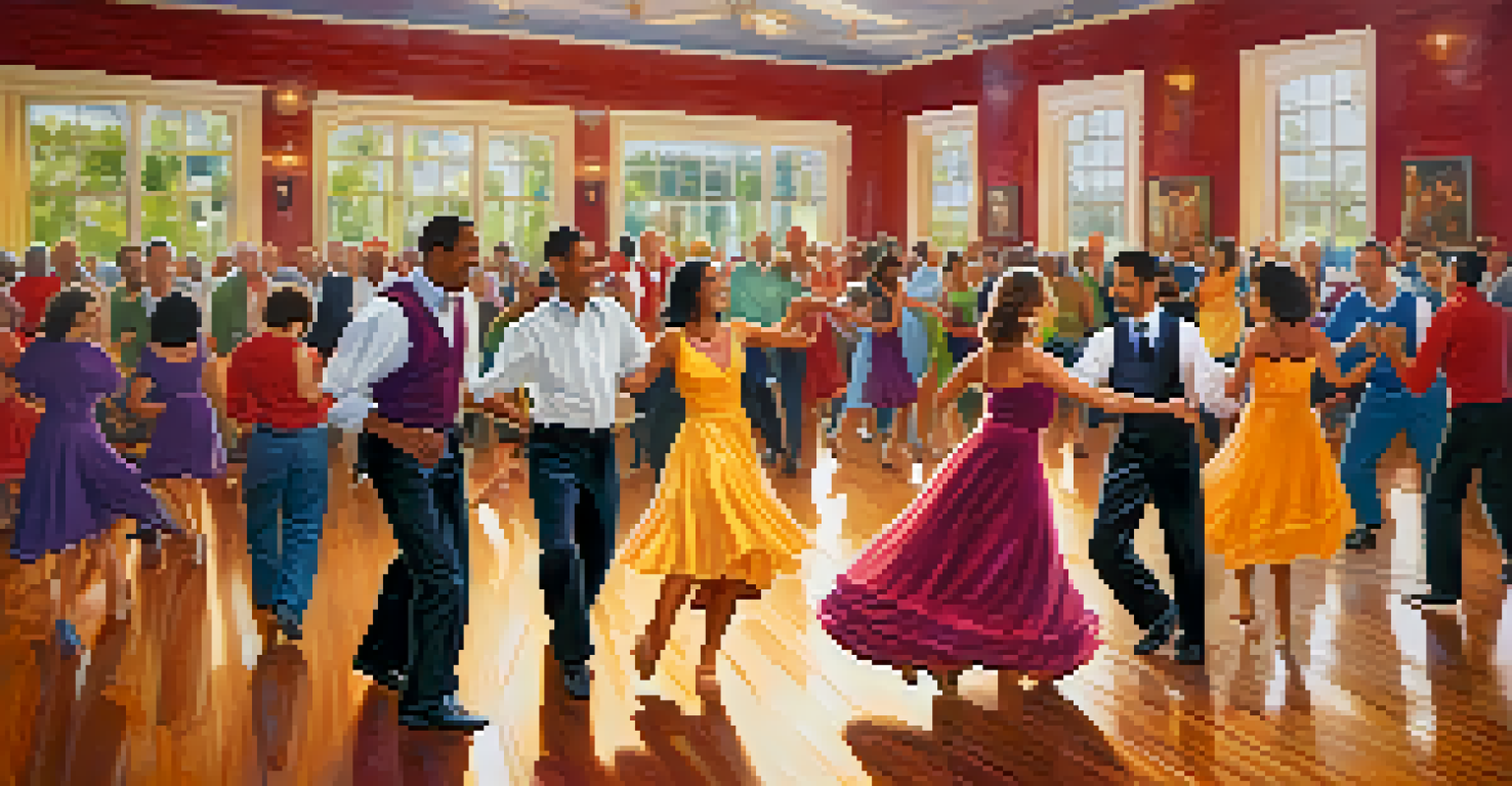Ballet vs. Social Dance: Understanding Their Differences

What is Ballet and Its Unique Characteristics?
Ballet is a highly technical form of dance that emphasizes precision and artistry. Originating in the Italian Renaissance courts, it has evolved into various styles, including classical ballet and contemporary ballet. Dancers often undergo extensive training, focusing on technique, posture, and expression.
Dance is the hidden language of the soul.
The movements in ballet are often graceful and fluid, designed to tell a story or convey emotion through structured choreography. Each performance is typically set to classical music, enhancing the overall aesthetic experience. Ballet also includes specific terminology and positions, such as plié and pirouette, which dancers learn over time.
Moreover, the attire is distinctive, with tutus and pointe shoes being iconic in classical ballet. The discipline and dedication required are immense, making ballet a revered art form worldwide. In essence, ballet is about creating beauty through stringent techniques and artistic expression.
Understanding Social Dance: A More Casual Approach
Social dance, on the other hand, encompasses a variety of dance styles that are often less formal and more accessible. Examples include salsa, swing, and ballroom dancing, where the primary focus is on enjoyment and social interaction rather than technical precision. Social dance allows for personal expression and improvisation, making it appealing to many.

Unlike ballet, social dance usually occurs in informal settings like parties or clubs, fostering a communal atmosphere. The music varies widely, from pop to jazz, reflecting a diversity of cultural influences. This variety means that anyone can join in, regardless of their skill level.
Ballet: Precision and Artistry
Ballet is a highly technical dance form that emphasizes rigorous training, structured choreography, and artistic expression.
Furthermore, social dance often adapts to the rhythm and mood of the music, allowing dancers to connect with each other. The emphasis is on having fun and enjoying the moment rather than perfecting every move. This makes social dance a great way to meet new people and develop a sense of community.
Key Technical Differences Between Ballet and Social Dance
One of the most notable differences between ballet and social dance lies in their technical demands. Ballet focuses on specific techniques and forms, with a strong emphasis on posture and alignment. Dancers often train for years to master these intricate movements, which require rigorous discipline and commitment.
Ballet is like a game of chess. It requires strategic thinking, discipline, and an understanding of the body’s mechanics.
In contrast, social dance typically prioritizes rhythm and adaptability over strict technique. Dancers are encouraged to interpret the music in their own way, leading to a more relaxed and spontaneous style of movement. This openness allows for a broader range of self-expression, appealing to those who might find ballet too rigid.
While both forms of dance can be physically demanding, the expectations differ greatly. Ballet’s structured approach contrasts with social dance’s more fluid and improvisational nature, highlighting the unique experiences each offers to dancers.
The Role of Performance in Ballet vs. Social Dance
Performance plays a crucial role in ballet, where dancers often showcase their skills in front of an audience. These performances are choreographed meticulously, emphasizing storytelling through movement and music. As a result, the experience can be quite theatrical, with elaborate costumes and staging enhancing the visual spectacle.
In social dance, while performances can happen, they are generally less formal. Social dancing often occurs in a more casual environment, where the emphasis is on participation rather than spectacle. People dance together for enjoyment, and while some may perform in competitions, the atmosphere remains more relaxed.
Social Dance: Fun and Connection
Social dance focuses on enjoyment and personal expression, allowing dancers to connect in a more relaxed and informal environment.
This difference in performance culture highlights the diverse purposes of the two dance styles. Ballet often seeks to inspire awe and admiration, while social dance aims to foster connection and enjoyment among participants.
Cultural Influences on Ballet and Social Dance
Cultural influences significantly shape both ballet and social dance. Ballet, with its European roots, often reflects the historical and artistic movements of its time, such as the Renaissance and Romantic eras. This heritage impacts the themes, music, and styles portrayed in ballet performances, making them rich in tradition.
On the other hand, social dance is a melting pot of cultures, drawing elements from various traditions and musical genres. For instance, the influence of Latin music can be seen in dances like salsa, while swing dance captures the essence of the jazz era. This diversity creates a dynamic and evolving landscape for social dance.
As cultures continue to blend, both ballet and social dance adapt, incorporating new styles and influences. This ongoing evolution not only enriches the dance forms but also keeps them relevant and engaging for new generations of dancers.
Training and Skill Development: Different Paths
The training pathways for ballet and social dance differ significantly, reflecting their unique approaches. Ballet training is typically formal and structured, often starting at a young age. Dancers may attend specialized schools, undergo rigorous conditioning, and participate in competitions to hone their skills.
Conversely, social dance training can be more informal, with many people learning through community classes or social gatherings. This approach allows for a more approachable entry into dance, where individuals can quickly pick up the basics and start enjoying themselves. Classes may focus on leading and following techniques, encouraging a collaborative atmosphere.
Different Training Paths
Ballet training is formal and disciplined, while social dance encourages a more casual and community-oriented approach to learning.
While both forms require practice and dedication, the paths diverge based on personal goals and preferences. Aspiring dancers should consider their motivations and interests when choosing the right training for them.
The Joy of Dance: Ballet vs. Social Dance Experience
At the heart of both ballet and social dance is the joy of movement and expression. Ballet offers a sense of grace and artistry, allowing dancers to immerse themselves in a world of elegance and storytelling. The satisfaction of mastering a challenging routine can be immensely rewarding, creating a deep appreciation for the art form.
In contrast, social dance promotes a sense of community and connection. The shared experience of dancing with others fosters friendships and enhances social interaction. Whether it's a lively salsa night or a casual swing dance, the fun and spontaneity of social dance create memorable experiences.

Ultimately, both ballet and social dance provide unique avenues for self-expression and enjoyment. Regardless of the style, the act of dancing is a celebration of movement that brings people together, enriching lives through rhythm and connection.